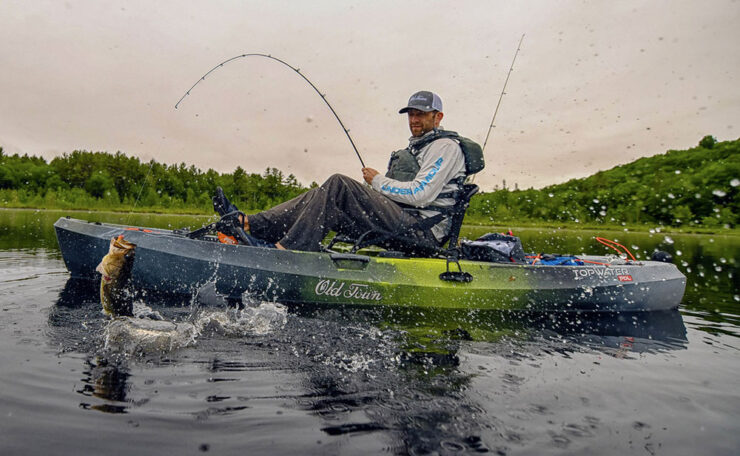Kayak fishing is great.
I love easy paddling on a beautiful stream or river, and being able to surgically target likely places to catch fish. I’ve been doing it for over 40 years, long before it became popular.
Needless to say, until recently, I never read much about kayak fishing, and when I did, I was a bit taken aback. Apparently, everything I have been doing for over half a century has been wrong.
It is not my intention to be argumentative, or make any assumptions about anyone’s opinions. But I feel that information on a lot of stuff nowadays is geared more towards selling merchandise rather than providing real information.
My goal is to try to put things in perspective, at least as far as kayaks are concerned.
Table of Contents
ToggleD0 I Need A Specific Kayak Type to go Fishing?
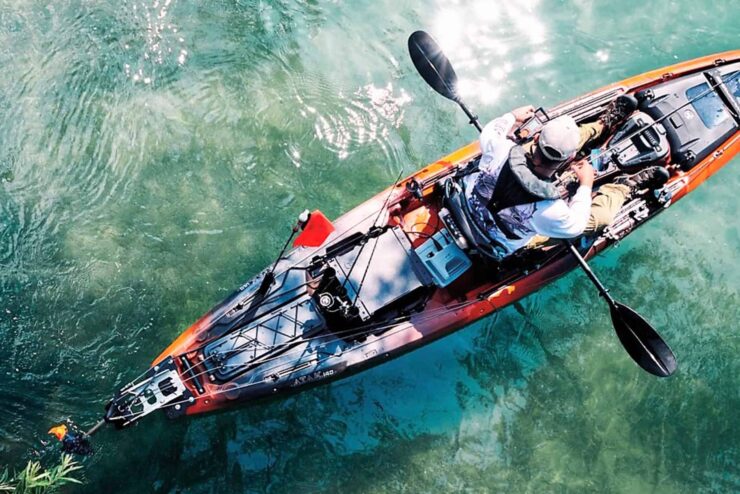
According to all the hype, in order to fish from a kayak, you need a special yak, most likely a Sit On Top (SOT) style, equipped with a pedal-drive, pontoons, battery-powered SONAR, etc….
Kayak Fishing Gurus tout techniques and equipment that would make a Bass Tournament addict salivate.
I have enough experience to say with complete confidence that you do not have to have a special kayak to fish.
Any kayak that floats, even a whitewater model, will work for fishing. SOTs are not my favorite model, but they do work. I never heard of a SOT until the 1980s, after rotomolding was perfected. I personally do not consider a SOT a kayak, because you can’t do half of the things you can do in a Sit Inside Kayak (SIK).
All the ones I have paddled seemed slow, unstable with a higher center of gravity, and they maneuvered like a pregnant manatee. SOTs were developed from paddleboards, which were just the old-style long surfboards that people stood on and paddled. Rotomolding allowed manufacturers to make them with integrated seats and footrests.
But again, if you like them, by all means, go out and catch some fish in one. I’ve used them a few times. They do offer a little less cluttered ride than a cockpit, but it comes at the expense of protection from some of the elements, the ability to roll, and a few other maneuvers.
Again, any kayak that floats can be used for fishing. All you really need to fish is something to hold a hook, bait, or a lure (and yes, I have used cane poles and tight-lined from a kayak), and a paddle.
So when you are looking for a kayak to fish from, pick the yak you feel the best in, and don’t worry about the accessories. You can add those yourself, later, if you feel they are needed. Put your money into the boat, not the accessories. Don’t buy a $200.00 yak with $500.00 worth of accessories on it, unless you really want it.
EXCURSION PRO – Good Inflatable Fishing Kayak Option
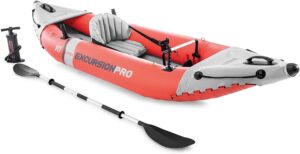
Can A Big Fish Drag My Kayak Away While Fishing?
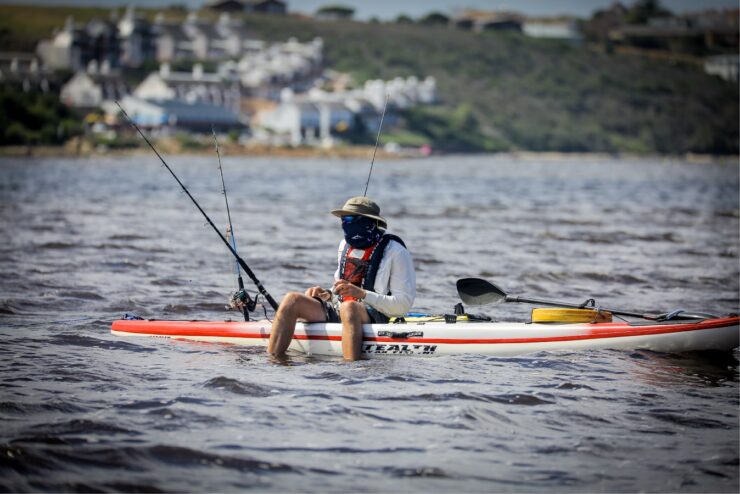
I have actually read articles about kayak fishing that claim you have to compensate for ‘lure drag’ on the retrieve, especially when using lures with extreme action, like crankbaits.
Huh? When I first read it, I thought it was satire, but no, the people were supposed to be ‘Professional Kayak Tournament’ anglers. I didn’t even know they had ‘Kayak Fishing’ Tournaments. But, sure enough, I’ve seen the same claims on dozens of websites. What are they using for lures, mini-submarines????
In all my decades of kayak fishing (none of it in tournaments), I have never had a lure move my yak towards it, no matter how hard I reeled. The nose may pivot slightly, but no ‘drag’. The pivot is mostly from shifting my weight from casting to reeling. I mostly use a 4-8 lb. fishing line.
Any force strong enough to pull my yak would break the line, and probably my rod as well. The reel’s drag would kick in way before that point if it was set properly. But we’ll get more into this in a minute.
I have also read stories of being dragged by fish into unsafe conditions. Now, I will admit that if you have the brass to go ocean fishing in a yak, yes, there are lots of fish that can take you for a ride, which is why I do not recommend it. In freshwater….very unlikely.
Maybe a very large Musky, or catfish, gar, or even a husky carp might drag you a little way if you don’t have your reel drag set correctly, but 95% of the time, this will not be an issue. I put both of these claims into the same category as the “Huge catfish by the dam that eats divers, so no one will ever dive there….”.
Anytime I go to a new area, I have a standing bet with my wife on how long it takes for a local resident to come up and tell me this story about the nearby lakes and rivers.
Safety First: Can it Actually Be Dangerous To Fish From A Kayak?
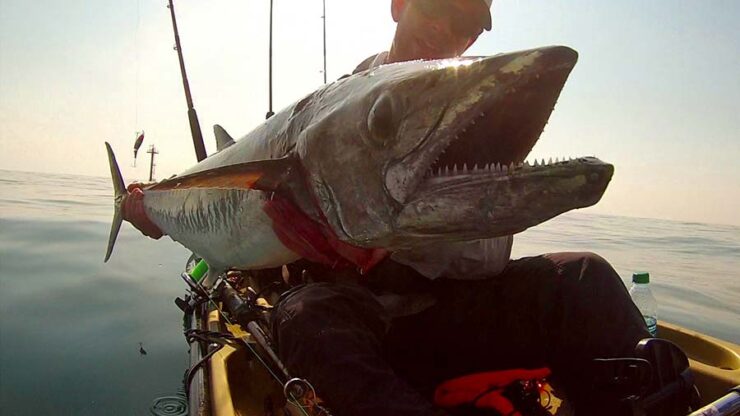
Let’s examine the previous claims from a scientific point of view.
I believe that Newton’s Laws of Motion are pretty well established by now. The First Law states that an object at rest or in motion will continue in that state until outside forces are acted upon it. If the forces are unbalanced, the object will accelerate in the direction of the net, or larger, force.
The Second Law gives us the mathematics for calculating acceleration. It is, “Force = mass x acceleration/s². The Force means the Net Force, which brings us to Newton’s Third Law.
Every action has an equal and opposite reaction, which is equal in force. This means that Net Force is the sum of the two forces. However, they do not cancel each other out, because the two forces are acting on two different things.
The equal reaction is the object itself, and the opposite reaction is the medium the object is moving through, or up against. So, if a force of 10 pounds is exerted in one direction, an equal force of 10 pounds will be exerted in the opposite direction, taking into account the circumstances at the time.
We’ll skip that part for now just for simplicity, so the Net Force will only be 5 pounds in this case. Force is measured in Newtons, which is the amount of force it takes to accelerate 1 kg (a little over 2 pounds) at a rate of 1 meter per second, per second, or 1m/s².
When a fish flips its tail to move, only a portion of that force goes to forward motion, with the rest moving water rearward. The same is true for a lure. And actually, it would be even less because the fish also has to overcome the drag of the water, current, etc…
So, let’s say we are fishing with an 8 lb. test line, and we just weigh 160 lbs (I wish…. I am trying to give the fish a fair chance…) and our yak weighs 40 pounds… a good average. We will assume calm water, no wind, or any other variables just for the sake of argument.
We hook a 10 lb bass that has been eating steroids and is capable of achieving triple its weight in thrust, which is unlikely, but we will go with that for simplicity. So our bass has poured on the coal and has kicked in all 30 pounds of possible thrust.
This calculates out to around 133 Newtons. But wait, according to Newton’s Third Law, only some of this will be forward thrust. For simplicity, we will assume ¾ of this is translated into forwarding thrust, so now we only have around 44 Newtons available.
Our combined Kayak and paddler weight is 200 pounds, which will require a force of 890 Newtons just to match the same acceleration. To move it at all will require a force of at least 400 Newtons. From a mathematical perspective, the absurdity is obvious.
A very large carp, say 40 pounds or so, may be able to slowly drag a kayak a few feet, very slowly for a few seconds …hardly a sleigh ride. And, don’t forget, even if we use a 10-pound line, it will break at around 40 Newtons, so dragging the boat is really not an issue.
This is not to say a fish could not cause the yak to pivot when pulling at an angle, which would take far less force than dragging it.
This could give the fish enough leverage to get into the structure, so that may be a concern. But dragging…hardly…. And if a 10-pound bass can’t do it, a ¼ oz., or even 1 oz. the lure is not going to do it.
You can prove this to yourself easily. Next time you are out, and you get hung up, try pulling your yak over to it just by pulling with the rod, and see how hard it is, then imagine what kind of fish it would take to do the same thing.
I hope this dispels some of the notions that have been bandied about. I do have an open mind. If anyone has videos, that can be proven not to have been staged or hoaxed, of an average-sized freshwater fish actually towing a kayak at any significant rate, I would really like to see it.
And if you ever actually see the diver-eating catfish…..vids, pleas!
Conclusion: My Experience Fishing From Kayaks
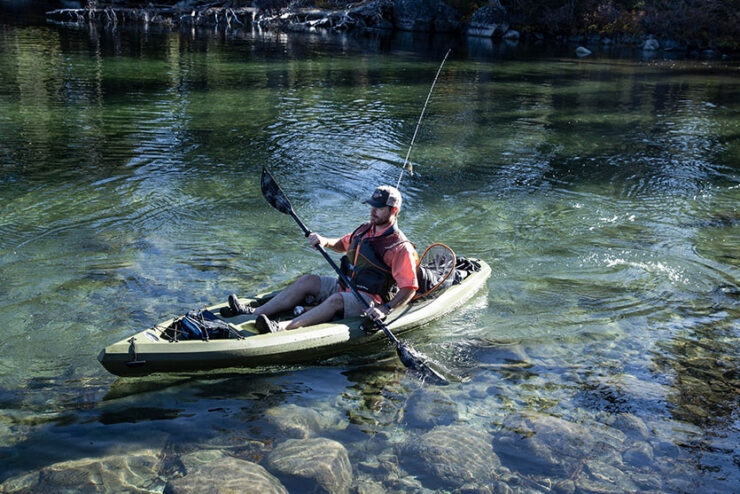
I do not claim to be a ‘Guru’. I just been kayak fishing for over 40 years, mostly in the US, in freshwater. I’ve done some flats and a little coastal fishing, but I do not personally recommend ocean fishing from a kayak. I have a rule when fishing, my boat has to be a little bigger than the fish I am trying to catch, especially if it can eat me.
Charter boats are very reasonable and a lot safer. That is just my personal opinion. Sure, primitive people hunt whales in kayaks, but I don’t have to. If you are one of those who like ‘Extreme’ fishing, more power to you.
I started kayak fishing long before it was popular.
In the early 1970s, I did a school report on kayaks and got interested in them. At that time, a company called Folbot was running ads in fishing and outdoor magazines for a folding kayak.
I had some money saved up from various odd jobs, so (with my parent’s permission) I ordered one by mail. It was not anything special other than being able to be folded for easy transport. But it was a great all-around kayak in all but the most vicious whitewater and made a wonderful fishing platform.
Adelaide Gentry, a seasoned kayaking enthusiast and expert, is the driving force behind KayakPaddling.net. With over a decade of experience navigating the world’s most challenging waterways, Adelaide combines her passion for adventure with a deep knowledge of kayaking to provide insightful and practical guidance for paddlers of all levels.
Related Posts:
- 12 Best Motorized Kayak 2024 - Start Your Aquatic Adventure!
- Heavy Duty Fishing: 11 Best Rods And Reels For Big Fish 2024
- 10 Best Inflatable Kayak 2024 - Rivers, Lakes & Open Seas
- 16 Best Kayak For Beginners 2024 - Kayaking Adventure Gear
- 10 Best Saltwater Fishing Boats - Ultimate Angling Adventure
- 13 Best Fishing Kayak Under $500 in 2024 -…

